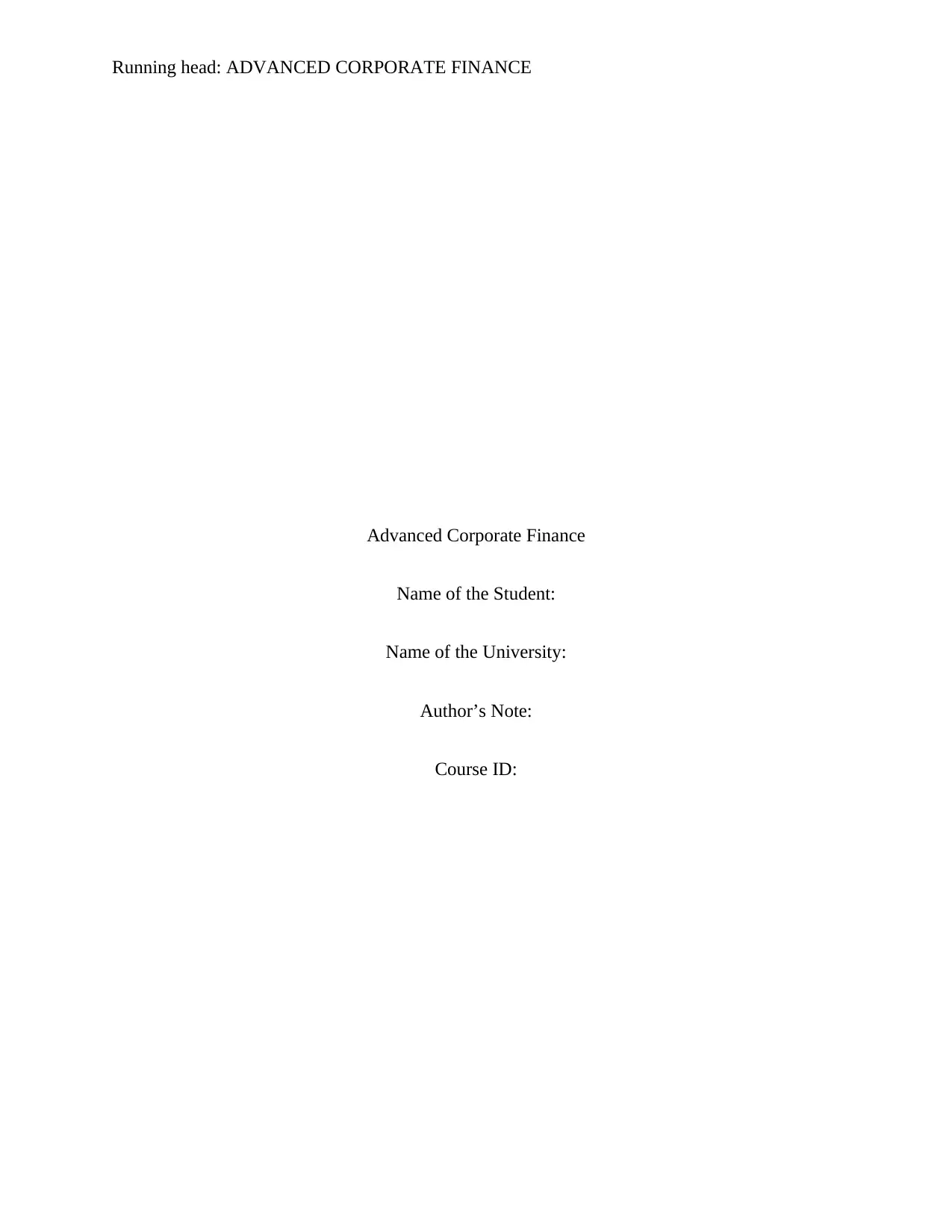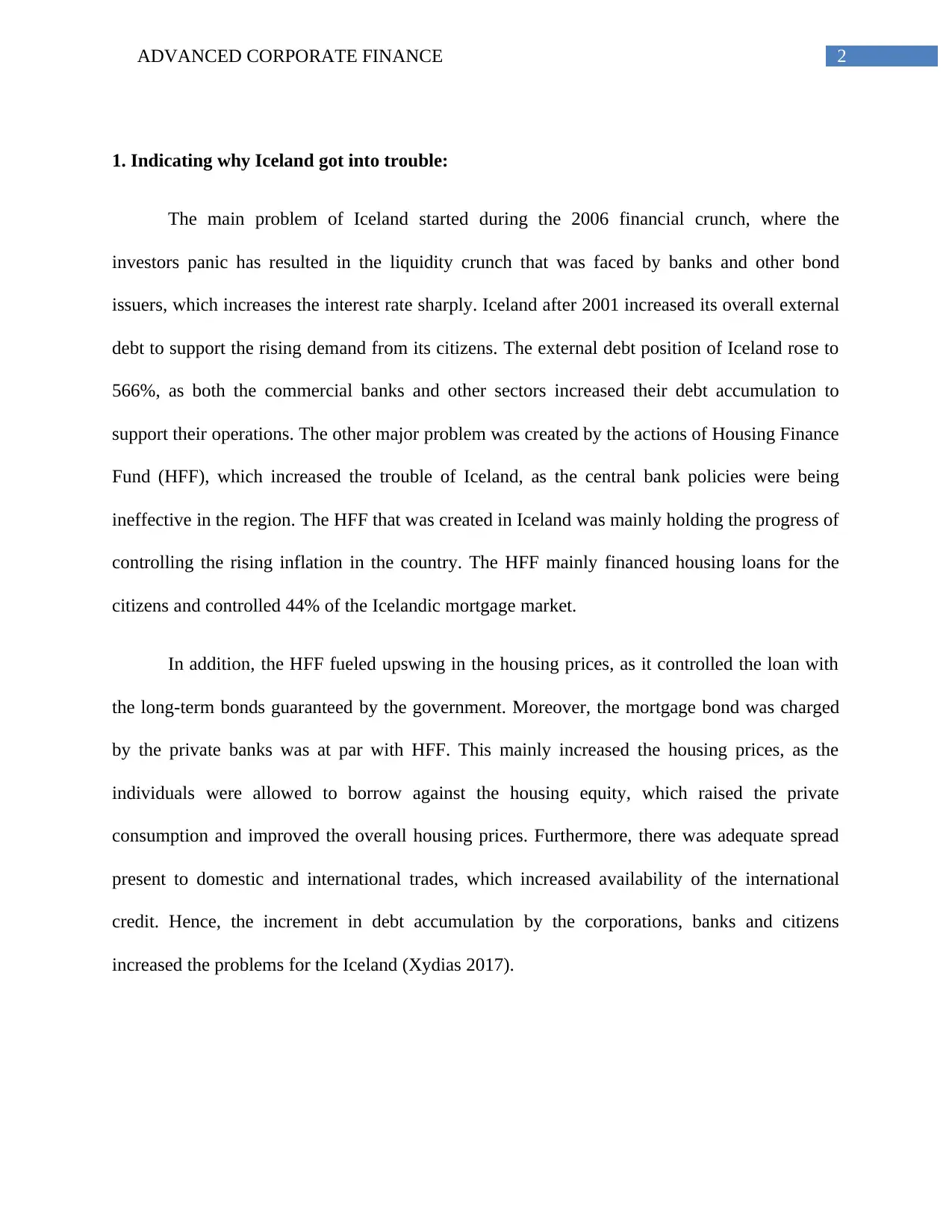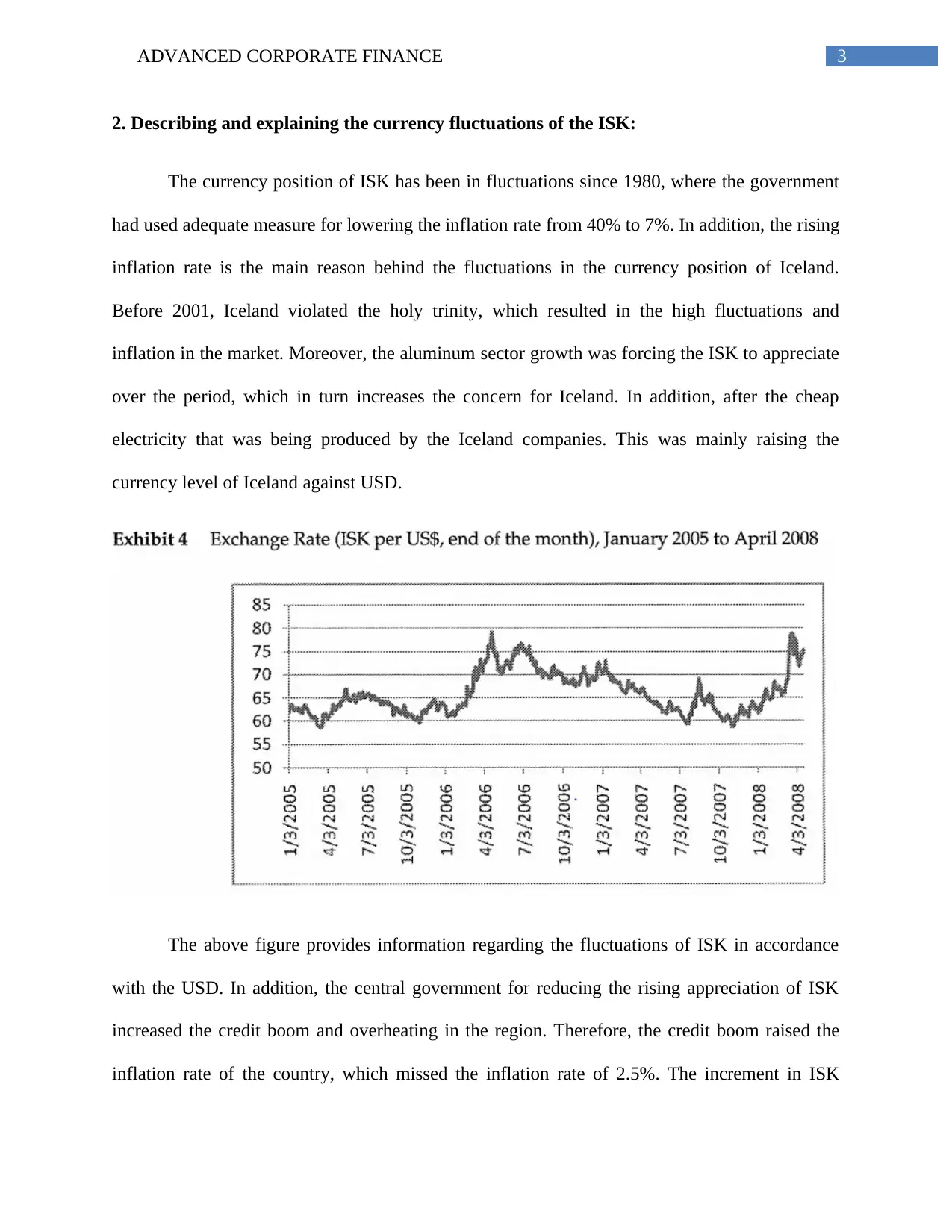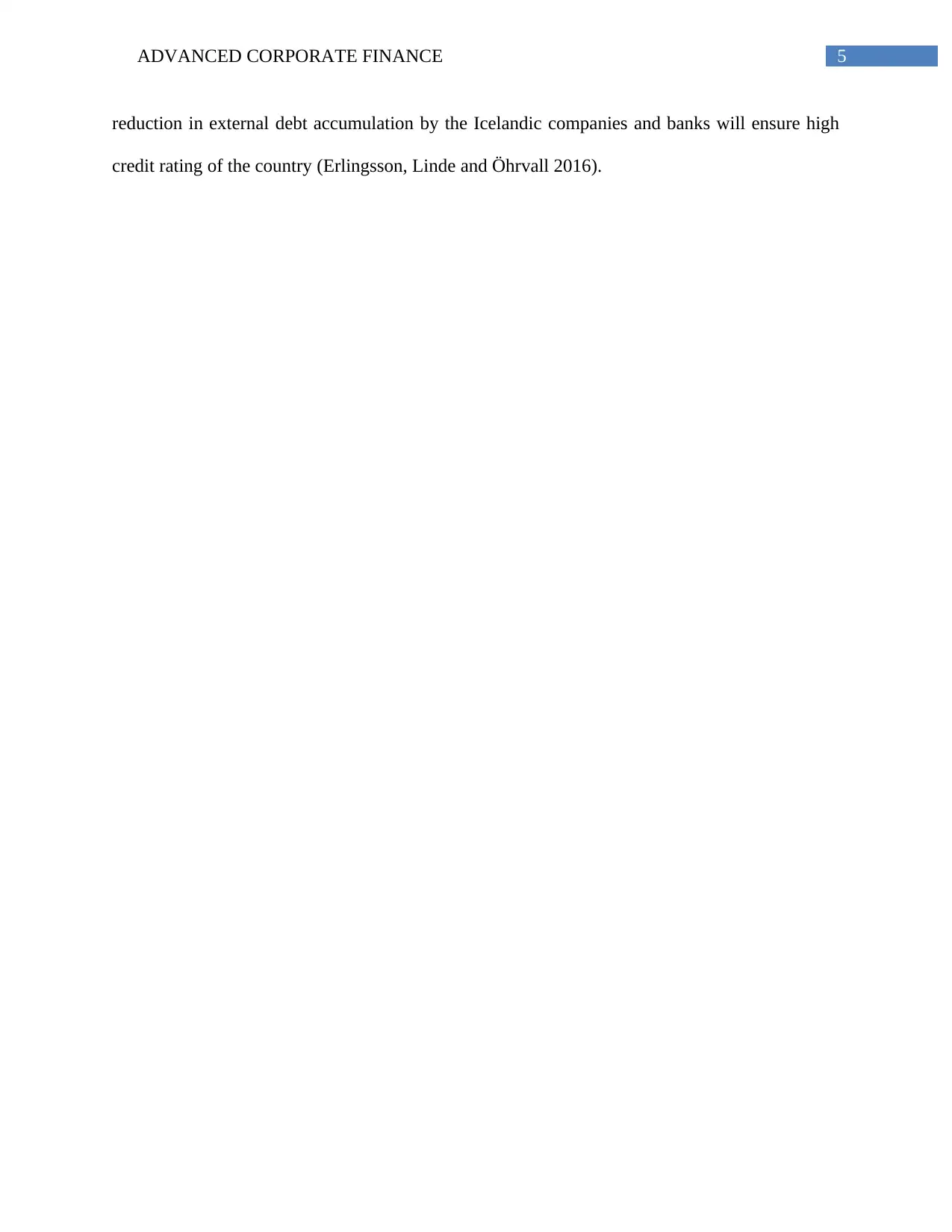Case Study: Analyzing Iceland's Financial Crisis, ISK and Solutions
VerifiedAdded on 2023/04/21
|7
|1194
|321
Case Study
AI Summary
This case study examines the 2006 financial crisis in Iceland, focusing on the factors that led to the country's economic troubles, including rising external debt, ineffective central bank policies, and the role of the Housing Finance Fund (HFF). It describes the fluctuations of the Icelandic Krona (ISK) since 1980, attributing them to inflation, aluminum sector growth, and credit booms. The study suggests solutions such as adopting appropriate monetary policies, reducing the impact of HFF, managing credit composition, and potentially pegging the currency to maintain competitiveness. Ultimately, reducing external debt accumulation is crucial for Iceland's long-term financial stability. Desklib offers a platform for students to access similar solved assignments and study resources.

Running head: ADVANCED CORPORATE FINANCE
Advanced Corporate Finance
Name of the Student:
Name of the University:
Author’s Note:
Course ID:
Advanced Corporate Finance
Name of the Student:
Name of the University:
Author’s Note:
Course ID:
Paraphrase This Document
Need a fresh take? Get an instant paraphrase of this document with our AI Paraphraser

1ADVANCED CORPORATE FINANCE
Table of Contents
1. Indicating why Iceland got into trouble:......................................................................................2
2. Describing and explaining the currency fluctuations of the ISK:................................................2
3. Indicating the solution of Iceland’s problems today, while mentioning several options:...........4
References and Bibliography:..........................................................................................................5
Table of Contents
1. Indicating why Iceland got into trouble:......................................................................................2
2. Describing and explaining the currency fluctuations of the ISK:................................................2
3. Indicating the solution of Iceland’s problems today, while mentioning several options:...........4
References and Bibliography:..........................................................................................................5

2ADVANCED CORPORATE FINANCE
1. Indicating why Iceland got into trouble:
The main problem of Iceland started during the 2006 financial crunch, where the
investors panic has resulted in the liquidity crunch that was faced by banks and other bond
issuers, which increases the interest rate sharply. Iceland after 2001 increased its overall external
debt to support the rising demand from its citizens. The external debt position of Iceland rose to
566%, as both the commercial banks and other sectors increased their debt accumulation to
support their operations. The other major problem was created by the actions of Housing Finance
Fund (HFF), which increased the trouble of Iceland, as the central bank policies were being
ineffective in the region. The HFF that was created in Iceland was mainly holding the progress of
controlling the rising inflation in the country. The HFF mainly financed housing loans for the
citizens and controlled 44% of the Icelandic mortgage market.
In addition, the HFF fueled upswing in the housing prices, as it controlled the loan with
the long-term bonds guaranteed by the government. Moreover, the mortgage bond was charged
by the private banks was at par with HFF. This mainly increased the housing prices, as the
individuals were allowed to borrow against the housing equity, which raised the private
consumption and improved the overall housing prices. Furthermore, there was adequate spread
present to domestic and international trades, which increased availability of the international
credit. Hence, the increment in debt accumulation by the corporations, banks and citizens
increased the problems for the Iceland (Xydias 2017).
1. Indicating why Iceland got into trouble:
The main problem of Iceland started during the 2006 financial crunch, where the
investors panic has resulted in the liquidity crunch that was faced by banks and other bond
issuers, which increases the interest rate sharply. Iceland after 2001 increased its overall external
debt to support the rising demand from its citizens. The external debt position of Iceland rose to
566%, as both the commercial banks and other sectors increased their debt accumulation to
support their operations. The other major problem was created by the actions of Housing Finance
Fund (HFF), which increased the trouble of Iceland, as the central bank policies were being
ineffective in the region. The HFF that was created in Iceland was mainly holding the progress of
controlling the rising inflation in the country. The HFF mainly financed housing loans for the
citizens and controlled 44% of the Icelandic mortgage market.
In addition, the HFF fueled upswing in the housing prices, as it controlled the loan with
the long-term bonds guaranteed by the government. Moreover, the mortgage bond was charged
by the private banks was at par with HFF. This mainly increased the housing prices, as the
individuals were allowed to borrow against the housing equity, which raised the private
consumption and improved the overall housing prices. Furthermore, there was adequate spread
present to domestic and international trades, which increased availability of the international
credit. Hence, the increment in debt accumulation by the corporations, banks and citizens
increased the problems for the Iceland (Xydias 2017).
⊘ This is a preview!⊘
Do you want full access?
Subscribe today to unlock all pages.

Trusted by 1+ million students worldwide

3ADVANCED CORPORATE FINANCE
2. Describing and explaining the currency fluctuations of the ISK:
The currency position of ISK has been in fluctuations since 1980, where the government
had used adequate measure for lowering the inflation rate from 40% to 7%. In addition, the rising
inflation rate is the main reason behind the fluctuations in the currency position of Iceland.
Before 2001, Iceland violated the holy trinity, which resulted in the high fluctuations and
inflation in the market. Moreover, the aluminum sector growth was forcing the ISK to appreciate
over the period, which in turn increases the concern for Iceland. In addition, after the cheap
electricity that was being produced by the Iceland companies. This was mainly raising the
currency level of Iceland against USD.
The above figure provides information regarding the fluctuations of ISK in accordance
with the USD. In addition, the central government for reducing the rising appreciation of ISK
increased the credit boom and overheating in the region. Therefore, the credit boom raised the
inflation rate of the country, which missed the inflation rate of 2.5%. The increment in ISK
2. Describing and explaining the currency fluctuations of the ISK:
The currency position of ISK has been in fluctuations since 1980, where the government
had used adequate measure for lowering the inflation rate from 40% to 7%. In addition, the rising
inflation rate is the main reason behind the fluctuations in the currency position of Iceland.
Before 2001, Iceland violated the holy trinity, which resulted in the high fluctuations and
inflation in the market. Moreover, the aluminum sector growth was forcing the ISK to appreciate
over the period, which in turn increases the concern for Iceland. In addition, after the cheap
electricity that was being produced by the Iceland companies. This was mainly raising the
currency level of Iceland against USD.
The above figure provides information regarding the fluctuations of ISK in accordance
with the USD. In addition, the central government for reducing the rising appreciation of ISK
increased the credit boom and overheating in the region. Therefore, the credit boom raised the
inflation rate of the country, which missed the inflation rate of 2.5%. The increment in ISK
Paraphrase This Document
Need a fresh take? Get an instant paraphrase of this document with our AI Paraphraser

4ADVANCED CORPORATE FINANCE
fluctuations is due to the rising demand of external debt from other financial services to support
the customer needs. The credit market of Iceland is directly affected by the externa debt market
that is used by the banks and the companies to support their financial requirements. This is the
main reason why the fluctuations in the ISK is seen during the period of 2005 to 2008. The credit
crunch during the 2006 was the main reason behind the depreciation of ISK against USD, where
the banks increased their borrowings to support the rising demand from cash crunch (Bernburg
2016).
3. Indicating the solution of Iceland’s problems today, while mentioning several options:
The main problems of Iceland are with the rising credit issues that was being conducted
by the banks and companies within the region. Therefore, adequate measure can be used for
curbing the rising problems of Iceland by changing the credit position of the banks and
companies. In addition, the major problems that is faced by the organization during the financial
crisis was the lack of adequate funding the credit downgrade of the country by specific credit
rating agencies. The high accumulation of external debt has raised the problems for Iceland and
increased the inflation and fluctuations in their currency market. Therefore, the government of
Iceland needs to adopt adequate monetary policy by reducing the impact of HFF and shaping
adequate changes in the credit composition of banks and other companies.
In addition, after shaping the adequate monetary policy the Iceland government also
needs to adopt pegging method for reducing appreciation of its currency and maintain
satisfactory currency levels to increase the competitiveness of the exporting companies.
Therefore, the government of Iceland needs to be maintained relevant level of credit conditions
for reducing the impact next credit crunch which might occur in the country. Hence, the
fluctuations is due to the rising demand of external debt from other financial services to support
the customer needs. The credit market of Iceland is directly affected by the externa debt market
that is used by the banks and the companies to support their financial requirements. This is the
main reason why the fluctuations in the ISK is seen during the period of 2005 to 2008. The credit
crunch during the 2006 was the main reason behind the depreciation of ISK against USD, where
the banks increased their borrowings to support the rising demand from cash crunch (Bernburg
2016).
3. Indicating the solution of Iceland’s problems today, while mentioning several options:
The main problems of Iceland are with the rising credit issues that was being conducted
by the banks and companies within the region. Therefore, adequate measure can be used for
curbing the rising problems of Iceland by changing the credit position of the banks and
companies. In addition, the major problems that is faced by the organization during the financial
crisis was the lack of adequate funding the credit downgrade of the country by specific credit
rating agencies. The high accumulation of external debt has raised the problems for Iceland and
increased the inflation and fluctuations in their currency market. Therefore, the government of
Iceland needs to adopt adequate monetary policy by reducing the impact of HFF and shaping
adequate changes in the credit composition of banks and other companies.
In addition, after shaping the adequate monetary policy the Iceland government also
needs to adopt pegging method for reducing appreciation of its currency and maintain
satisfactory currency levels to increase the competitiveness of the exporting companies.
Therefore, the government of Iceland needs to be maintained relevant level of credit conditions
for reducing the impact next credit crunch which might occur in the country. Hence, the

5ADVANCED CORPORATE FINANCE
reduction in external debt accumulation by the Icelandic companies and banks will ensure high
credit rating of the country (Erlingsson, Linde and Öhrvall 2016).
reduction in external debt accumulation by the Icelandic companies and banks will ensure high
credit rating of the country (Erlingsson, Linde and Öhrvall 2016).
⊘ This is a preview!⊘
Do you want full access?
Subscribe today to unlock all pages.

Trusted by 1+ million students worldwide

6ADVANCED CORPORATE FINANCE
References and Bibliography:
Bernburg, J.G., 2016. Economic crisis and mass protest: The pots and pans revolution in
Iceland. Routledge.
Einarsson, B.G., Gunnlaugsson, K., Ólafsson, T.T. and Pétursson, T.G., 2015. The long history
of financial boom-bust cycles in Iceland-Part I: Financial crises. Central Bank of Iceland
Working Paper, (68).
Erlingsson, G.Ó., Linde, J. and Öhrvall, R., 2016. Distrust in utopia? Public perceptions of
corruption and political support in Iceland before and after the financial crisis of
2008. Government and Opposition, 51(4), pp.553-579.
Gudmundsdóttir, D.G., Ásgeirsdóttir, B.B., Huppert, F.A., Sigfúsdóttir, I.D., Valdimarsdóttir,
U.A. and Hauksdóttir, A., 2016. How does the economic crisis influence adolescents’ happiness?
Population-based surveys in Iceland in 2000–2010. Journal of Happiness Studies, 17(3),
pp.1219-1234.
Ingimundarson, V., Urfalino, P. and Erlingsdóttir, I. eds., 2016. Iceland’s Financial Crisis: The
Politics of Blame, Protest, and Reconstruction. Routledge.
Xydias, C., 2017. Citizens, Domestic Institutions, and International Organizations: Recent
Financial Crises in Greece and Iceland. Polity, 49(4), pp.518-547.
References and Bibliography:
Bernburg, J.G., 2016. Economic crisis and mass protest: The pots and pans revolution in
Iceland. Routledge.
Einarsson, B.G., Gunnlaugsson, K., Ólafsson, T.T. and Pétursson, T.G., 2015. The long history
of financial boom-bust cycles in Iceland-Part I: Financial crises. Central Bank of Iceland
Working Paper, (68).
Erlingsson, G.Ó., Linde, J. and Öhrvall, R., 2016. Distrust in utopia? Public perceptions of
corruption and political support in Iceland before and after the financial crisis of
2008. Government and Opposition, 51(4), pp.553-579.
Gudmundsdóttir, D.G., Ásgeirsdóttir, B.B., Huppert, F.A., Sigfúsdóttir, I.D., Valdimarsdóttir,
U.A. and Hauksdóttir, A., 2016. How does the economic crisis influence adolescents’ happiness?
Population-based surveys in Iceland in 2000–2010. Journal of Happiness Studies, 17(3),
pp.1219-1234.
Ingimundarson, V., Urfalino, P. and Erlingsdóttir, I. eds., 2016. Iceland’s Financial Crisis: The
Politics of Blame, Protest, and Reconstruction. Routledge.
Xydias, C., 2017. Citizens, Domestic Institutions, and International Organizations: Recent
Financial Crises in Greece and Iceland. Polity, 49(4), pp.518-547.
1 out of 7
Related Documents
Your All-in-One AI-Powered Toolkit for Academic Success.
+13062052269
info@desklib.com
Available 24*7 on WhatsApp / Email
![[object Object]](/_next/static/media/star-bottom.7253800d.svg)
Unlock your academic potential
Copyright © 2020–2025 A2Z Services. All Rights Reserved. Developed and managed by ZUCOL.




